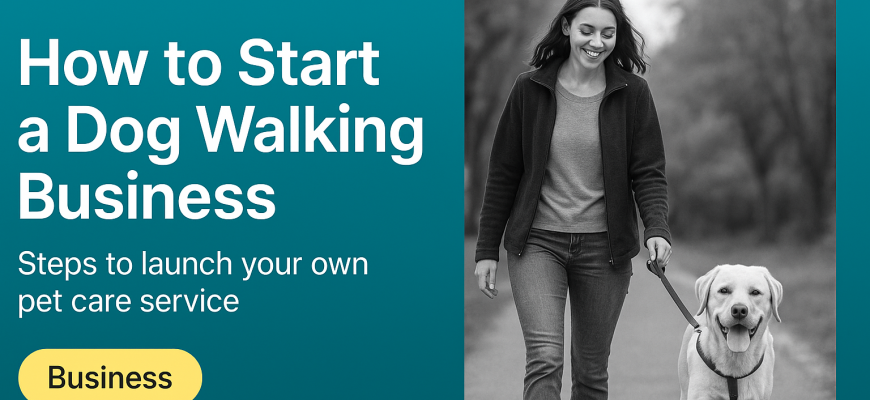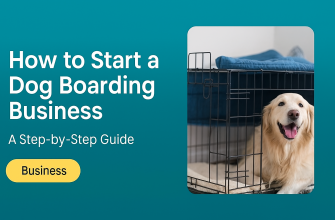Turning your passion into profit – it’s the dream of many aspiring entrepreneurs. If you’re a dog lover who lights up around four-legged friends, why not turn that enthusiasm into a thriving business? Imagine waking up each day excited to be your own boss and spend time outdoors with happy pups instead of sitting behind a desk. As women entrepreneurs, we often seek careers that are both fulfilling and flexible. Starting a dog walking business can offer exactly that: the chance to earn income on your own terms while doing something you genuinely love.
The best part? Demand for dog walkers is high and still growing. In the U.S. alone, over 65 million households have a dog – each one a potential client that needs help keeping their furry family members healthy and exercised. With many people returning to busy office schedules or traveling more, reliable pet care is in huge demand. Some dog walking services have even seen a 30% surge in bookings in recent years, so there’s never been a better time to start! And unlike some businesses, you won’t need a fortune to get up and running – this venture has relatively low startup costs (think leashes, comfy shoes, and maybe a simple website). Yet the income potential is very real. With dedication and smart strategies, dog walkers can scale their operations and earn impressive profits. (According to the New York Times, some top dog walkers make over $100,000 a year by expanding their services!)
Ready to embark on this pawsome journey? In this guide, I’ll walk you step-by-step through how to launch your dog walking business from scratch. We’ll go from dreaming about it to actually doing it – covering everything from planning and pricing your services to marketing yourself and building a loyal client base. Let’s dive in and turn your dog-loving passion into a profitable, empowering business venture!
Step 1: Research and Plan Your Dog Walking Business
Every successful business starts with a solid plan. Begin by doing your homework on the dog walking market in your area. This research and planning phase will be the foundation of your venture, so don’t skip it! Here’s how to get started:
-
Understand Your Local Market: Find out how many people in your community might need a dog walker. Are you in a city full of busy professionals or a suburban area with many pet-owning families? Look up local pet ownership stats if available, talk to dog owners, even chat with established dog walkers. Identify your target customers – for example, working pet parents, senior or disabled dog owners who need assistance, or anyone who travels often and can’t be home for Fido.
-
Scope Out the Competition: Investigate who else is offering pet-sitting or dog walking services nearby. What do they charge? What services do they offer (quick potty breaks, 30-minute walks, group walks, pet sitting, etc.)? Learning what’s already out there will help you figure out how to differentiate yourself. Maybe you’ll find a gap – like no one in your neighborhood does early-morning walks or weekend hikes with dogs – which could become your specialty.
-
Define Your Services: Get clear on exactly what you will offer when you launch. Will you focus solely on individual dog walks, or will you also offer related services like pet sitting, feeding visits, or dog park outings? When you’re just starting, it’s wise to keep it simple and excel at a few core services rather than stretching yourself too thin. You can always expand your offerings later once your business is stable.
-
Draft a Basic Business Plan: Now, map out the details. This doesn’t have to be a formal 20-page document – even a one-page outline is a great start. Write down your mission (e.g., “Provide reliable, loving dog exercise services for busy owners in [Your Town]”), your target customer profile, the services and pricing you plan to offer, and how you intend to market yourself. Also note any startup costs and what you’ll need to get started. Creating this business plan will give you a roadmap and make everything feel more real. As a bonus, if you ever seek a small loan or just need to explain your business to someone, you’ll already have your thoughts organized!
Coach’s Tip: Don’t be intimidated by the term “business plan.” Think of it as your vision on paper. It’s allowed to change and evolve – the important part is that you’re setting goals and thinking through how you’ll achieve them. When you write down your ideas, you’re turning dreams into something concrete. This empowering step will boost your confidence and clarify your next moves.
Step 2: Take Care of the Business Basics (Legalities & Logistics)
With your plan in hand, it’s time to set up the business side of your dog walking venture. This step might not be as fun as playing with puppies, but it’s crucial to do it right – and you’ll feel so accomplished when you can officially call yourself a business owner! Here’s your checklist for getting your foundation in place:
-
Choose a Business Name and Register It: Pick a name that is catchy, professional, and gives a hint of what you do. Since this will be your brand, make it something you love and that appeals to pet owners (for example, “Happy Paws Walking Co.” or “City Tails Dog Walking”). Once you have the perfect name, register it with your local authorities if required. You may also register a domain name (website address) now so nobody else grabs it.
-
Decide on a Business Structure: Will you operate as a sole proprietor or form an LLC (Limited Liability Company)? Many solo dog walkers start as a sole proprietor because it’s simple – you can always transition to an LLC later. An LLC can provide personal liability protection (separating your business finances from your personal assets), which becomes more important as you grow. Research what makes sense for you, and don’t hesitate to consult a professional if you’re unsure.
-
Obtain Licenses and Permits: Check your city and state requirements for small businesses. In many places, you need a basic business license to legally offer services. Some locales might have specific permits or regulations for pet services, so do a little digging – your city clerk’s office or state business website is a good place to start. The last thing you want is to unknowingly operate without a required license. Getting legit from the get-go will also make you more confident and credible.
-
Get Liability Insurance: This is a biggie. Dog walking might seem low-risk, but remember, you are dealing with beloved pets and entering clients’ homes. Insurance protects you in case a dog gets injured, slips out of its collar, or if any property gets damaged on your watch. Look for pet business insurance or general liability insurance that covers dog walking. It’s an added expense, but it can save you from huge losses and gives both you and your clients peace of mind. (Bonus: Being insured also makes you look more professional; you can even mention “insured and bonded” in your marketing to build trust.)
-
Set Your Policies & Contracts: Take a moment to think about how you’ll run your services day-to-day. What will be your cancellation policy if a client needs to reschedule? Will you offer refunds or make-up walks for bad weather? How will you handle keys to clients’ homes, or meet-and-greets with new dogs? It’s wise to draw up a simple service agreement or contract for clients to sign. This document should outline the basics: your responsibilities, the owner’s responsibilities (like having up-to-date vaccinations and secure collars), what happens in an emergency, and your policies on cancellations or late payments. Having clear terms in writing protects you and sets the right expectations with clients.
-
Prepare Your Equipment: One thing I love about dog walking is that you don’t need fancy gear or a huge upfront investment to start. Gather the essentials: a sturdy leash (plus maybe a backup), plenty of waste pick-up bags, a good pair of walking shoes, and perhaps some dog treats (with owner permission) to help you bond with your new canine clients. If you’ll be walking multiple dogs at once, consider a hands-free leash or leash splitter for safety. It’s also smart to carry a simple pet first aid kit for minor issues (and it shows owners that you’re conscientious about safety). As you grow, you might invest in extras like a travel water bowl, dog towels for rainy days, or even crates/carriers if you plan to transport dogs in your car. But initially, keep it basic and focused on keeping dogs safe and happy during their outings.
Taking care of these logistics might seem a bit overwhelming at first, but tackle them one by one. Once this step is done, you’ll have laid a professional foundation for your business. You will be officially open for business and ready to focus on what you do best – walking dogs and making clients happy!
Step 3: Define Your Services and Set Your Prices
Now let’s talk about what exactly you’ll offer and how much you’ll charge – the core of your business model. Getting this part right will ensure you attract clients and make a profit doing what you love.
Outline Your Dog Walking Services: Think about the details of your dog walks. Common offerings include a 30-minute walk or a 60-minute walk (either one-on-one with the dog or maybe two dogs from the same household). Will you offer group walks where you take several dogs from different families out together, or do you prefer solo walks only? Group walks can be more profitable (since two or three owners are paying you for the same time slot), but they require good control and only compatible dogs. Decide what’s manageable for you starting out. You can also consider add-ons or related services such as:
-
Feeding and refreshing the dog’s water bowl after the walk
-
Text or photo updates to the owner from each walk (many clients love a cute midday photo of their pup!)
-
Pet sitting or drop-in visits (if you want to extend services beyond walks, e.g. checking on cats or other small pets)
-
Weekend or evening walks for an extra fee, if you’re willing to work off-hours
When beginning, focus on a few key services you can excel at. You might start by advertising just a standard walk and a longer walk option, for example, and see what clients request. As you gain experience, you can expand your menu of services based on what your customers need.
Figure Out Your Pricing: Pricing can feel tricky, but it’s important to strike a balance between affordability and valuing your time. Start by researching the going rates in your area. How much do other dog walkers or pet sitters charge for similar services? If the average in your town is, say, $15–$25 for a half-hour walk, you’ll likely want to price in that range initially. Remember to account for factors like travel time and the effort involved. If a client is farther away or has multiple dogs, it’s reasonable to charge a bit more.
Make sure your pricing is clear and transparent. Clients should know exactly what they’re getting for the price – e.g. a 30-minute walk including feeding and a text update might be $20, while a one-hour walk with two dogs might be $30. List out anything that could incur additional fees (for example, an extra charge for a second dog, or a small fee for last-minute bookings or holiday walks). By being upfront, you avoid misunderstandings and show professionalism. It also helps to have your rates in writing (on your website or a flyer) so clients can easily see your offerings. Consider creating packages or discounts to encourage loyalty – for instance, a bundle of 5 walks at a slight discount, or a monthly subscription rate for daily walks. This not only rewards clients for consistent business but also provides you with steadier income.
When setting prices, don’t undervalue yourself. It’s common, especially for women entrepreneurs, to feel hesitant about charging what we’re worth. But remember: you are providing a valuable service that gives pet owners peace of mind (and gives their dogs a happier, healthier life!). Calculate your costs (gas, time, insurance, etc.) and ensure your rates leave you a reasonable profit for your effort. It’s okay to start on the lower end of the local range to attract your first clients, but plan to reassess and potentially raise your prices as you build a reputation and demand grows. You can even use online tools or rate calculators to help decide on competitive prices based on your location and expenses.
Coach’s Tip: Practice saying your prices confidently, whether in conversation or on your marketing materials. For example: “My rate is $25 per 30-minute walk, which includes a water refresh and a photo update.” Stating it plainly shows you’re confident in the value you provide. And if you ever doubt yourself, remember all the love and hard work you put into caring for each pet – you deserve to be compensated fairly for that!
Step 4: Brand and Market Your Dog Walking Business
With your services defined and pricing set, it’s time to let the world (or at least your community) know that your awesome dog walking business exists! This step is all about creating a brand identity and spreading the word so you can start getting clients.
Build Your Brand Identity: Branding is more than just a name and logo – it’s the personality of your business. As a woman entrepreneur and dog lover, you might bring a warm, personal touch to your brand that sets it apart. Use that to your advantage! If you haven’t already, design a simple logo (there are free online tools and templates, or affordable designers) that you can use on business cards, your website, and social media. Decide on a color scheme or style that feels right for your vibe (playful and fun, or maybe clean and professional – whatever fits you). Make sure your brand voice in any marketing is friendly, trustworthy, and passionate. Clients are trusting you with their fur-babies, so they need to feel they know and like you. Even a quick tagline like “Loving care when you can’t be there” or “Wag more, worry less – dog walking at its best!” can communicate your mission at a glance.
Create an Online Presence: In today’s world, being online is crucial for any small business. At the very least, set up a simple website or a dedicated Facebook business page that includes your services, prices, service area, and contact information. There are easy website builders that don’t require coding skills – a one-page site with your details and a few cute dog photos can work wonders. Also, claim your Google My Business listing (so that locals searching “dog walker near me” will find you) and any local directories. Leverage social media to connect with your community: you can post updates or helpful pet tips on Facebook or share photos of happy dogs on Instagram (with client permission, of course). Social media is free advertising if used well – join local pet or neighborhood groups online and let people know you’re available. Consistency is key: update your pages regularly, respond promptly to inquiries, and let your enthusiasm shine through.
Grassroots Marketing – Get the Word Out Locally: Not all marketing has to cost money, especially at the start. Spread the word among friends, family, and neighbors that you’re open for business – personal referrals often kickstart your client list. You can also print some flyers or business cards and post them on community bulletin boards (think coffee shops, libraries, dog parks, veterinary clinics). Make the flyer attractive and clear: include your logo/name, a brief list of services, your contact info, and maybe a short testimonial or a “first walk free!” special offer to entice new clients. Consider offering a limited-time grand opening deal, like a discounted first week or a buy-one-get-one-free walk, to encourage people to give your service a try.
Another savvy move is to network with complementary businesses. Introduce yourself to local pet groomers, dog trainers, veterinarians, and pet supply shops. Let them know you’re available if their clients ever need a dog walker, and see if you can leave some cards or flyers at their location. Maybe you can agree to refer clients to each other. For example, a groomer might mention you to someone who says they work all day and worry about their dog at home. In turn, you could recommend the groomer to your clients. This kind of win-win networking helps build your presence in the local pet community.
Don’t forget online platforms: you might create a profile on dog-walking apps like Rover or Wag. These can help you find clients initially since many pet owners turn to apps to find help. Keep in mind, these platforms will take a cut of your earnings and you’ll have to follow their rules. But they can be useful for gaining experience, collecting reviews, and filling your schedule when you’re just starting out. Even if your long-term goal is an independent business, there’s no harm in using multiple channels to get your name out there.
Shine on Social Media: Use social media strategically to market your services for free. For example, start an Instagram account for your business and post pictures from your walks (happy dogs enjoying the park make great content!). Share little stories or tips in your captions – this shows off your knowledge and love for the job. In local community Facebook groups or apps like Nextdoor, keep an eye out for anyone asking for dog walker recommendations and feel free to chime in with your services. Encourage your clients to tag you if they share a photo of their pet or to post a recommendation in local groups. Little by little, you’ll build a recognizable presence online.
Leverage Word-of-Mouth: The most powerful marketing often costs nothing at all. Pet owners trust other pet owners. Encourage your happy clients to tell their friends and neighbors about you. You might even set up a referral program – for example, a client gets a free walk or a discount if they refer a friend who becomes a paying customer. This way, your delighted customers become your sales team! Remember, small businesses like dog walking thrive on personal recommendations. Many people would rather hire someone their friend raves about than a stranger, so never underestimate the power of word-of-mouth. Focus on building those positive reviews and referrals, and your client base will grow naturally.
In short, be visible and enthusiastic. Carry yourself as the professional dog walker you are – you might be surprised how mentioning your new business in everyday conversations (at the dog park, at school pickup, at community events) can lead to your next client. Marketing is about building connections and trust, especially in a service as personal as caring for someone’s pet. You’ve got this – put yourself out there proudly!
Step 5: Build a Loyal Client Base and Reputation
Marketing may get clients in the door (or rather, tails on the trail), but excellent service is what keeps them coming back and brings you even more business. Now that you have some dogs to walk, focus on delivering a standout experience for both the dogs and their owners. Building a loyal client base is all about trust, reliability, and going the extra mile.
Deliver Paw-some Service: Treat every dog as if they were your own. Show up on time (or a few minutes early) for each appointment. Pay attention to each pet’s needs and personality – maybe one dog loves a slow, sniff-filled stroll while another needs an energetic jog to burn off energy. The more attuned you are to each animal, the more special your service will feel. During walks, prioritize safety: follow leash laws, be mindful of traffic and other dogs, and never leave a dog unattended. A professional, caring approach builds trust with owners. Many walkers send a quick update after each walk (like “Max had a great 30-minute walk today and enjoyed lots of playtime at the park!”), often with a photo of the happy pup. This kind of communication delights owners and reassures them that their beloved pet is in good hands. When clients see that you genuinely care about their dog’s well-being and happiness, they’ll be more than happy to stick with you – and recommend you to others.
Encourage Reviews and Testimonials: Social proof is gold for a service business. When you have a few happy customers, politely ask if they’d be willing to share a quick review or testimonial. They could post on your Google listing, Yelp, or Facebook page, or simply write a sentence or two that you can feature on your website. Positive reviews will boost your credibility for new clients who find you online. People searching for a dog walker love seeing comments like “She is so reliable and great with our pup! Hiring her was the best decision we made.” Don’t be shy about asking for this – most pet parents who appreciate your service will be glad to help a small business owner out.
Foster Personal Connections: One of the joys of running a dog walking business is the relationships you build – not just with the dogs, but with their humans too. Be friendly and approachable. Remember details about the pets and owners (like the dog’s birthday, or the family’s upcoming vacation). Little touches, such as leaving a thank-you note or a small treat for the dog during the holidays, can really set you apart. As a female entrepreneur, you can leverage those personal skills and empathy to create a sense of community around your business. When clients see you as more than just a service provider – essentially, a trusted friend who genuinely cares about their pet – they are likely to stay with you for the long haul and tell others about you.
Keep Learning and Improving: Building a business (and a reputation) is a continuous learning process. Be open to feedback from clients. If someone asks if you could, say, wipe their dog’s paws on rainy days, or spend a few extra minutes on a shy dog’s first walk to build trust, try to accommodate if you can. This flexibility and attention to client needs shows that you listen and are dedicated to providing great service. It’s also a good idea to educate yourself further whenever possible – for example, consider getting pet first aid certified or taking a dog behavior class. Not only will this knowledge help you handle tricky situations, but you can also mention your certifications in your marketing, which impresses clients and sets you apart as a true professional.
Grow at Your Own Pace: As your reputation spreads, you may find your schedule filling up quickly – congratulations! At this point, you have options to consider for growth. You could start a waitlist or raise your rates (a nice problem to have, right?). You might expand by hiring an assistant dog walker or partnering with another walker to cover more clients. If expansion is your goal, make sure to put systems in place (like clear training, additional insurance for employees, etc.) to maintain quality. On the other hand, you might decide you’re happy staying solo and keeping a manageable number of regular clients. There’s no one-size-fits-all definition of success. The beauty of running your own business is that you get to choose what growth looks like for you. Whether it’s scaling up to a team or staying a boutique operation, do what aligns with your personal goals and life balance.
Throughout all of this, stay encouraged and empowered. Every business has challenges – maybe a dog gets sick unexpectedly, or a client moves away – but those are just bumps on the road. Remind yourself of why you started: your love for dogs and your desire for a career on your terms. In tough times, lean on your support system. Connect with other pet professionals or women entrepreneurs (there are many groups and forums where people share advice). You’ll find that others have overcome the same hurdles, and you can too. Each challenge is an opportunity to learn and become even better at what you do.
Finally, celebrate your wins, big and small. Got your first client through a referral? High-five! Received a thank-you note from a client who says you made their life so much easier? That’s huge! Every happy dog tail wagging at your arrival is a sign you’re making a difference. When you consistently provide excellent service, your reputation will shine bright. In fact, if you do an amazing job, your customers will practically do your marketing for you by spreading the word to their friends and neighbors.
Ready, Set, Walk!
Starting a dog walking business is more than just a way to make money – it’s about creating a lifestyle of freedom, passion, and purpose. You’re not only turning your love of dogs into a paycheck, but also providing a service that truly helps people (and their pets). From the initial spark of an idea to putting on your walking shoes for your very first client, you’ve seen how each step can be tackled with a bit of planning and a lot of heart.
Always remember, every expert was once a beginner. The confidence and know-how you build will grow with each dog you walk and each client you wow. Trust yourself and the process. You’ve crafted a plan, handled the business nitty-gritty, set fair prices, put yourself out there, and committed to excellence – these are huge accomplishments in themselves.
So take a deep breath and pat yourself on the back for coming this far. Now, it’s time to put one foot in front of the other (literally!) and launch your dog walking business. You have all the tools and tips you need to succeed. Stay motivated, keep learning, and enjoy every moment of this journey – after all, your workday now involves wagging tails and outdoor adventures!









